The Gem of the Ocean - Our American Navy - 1918
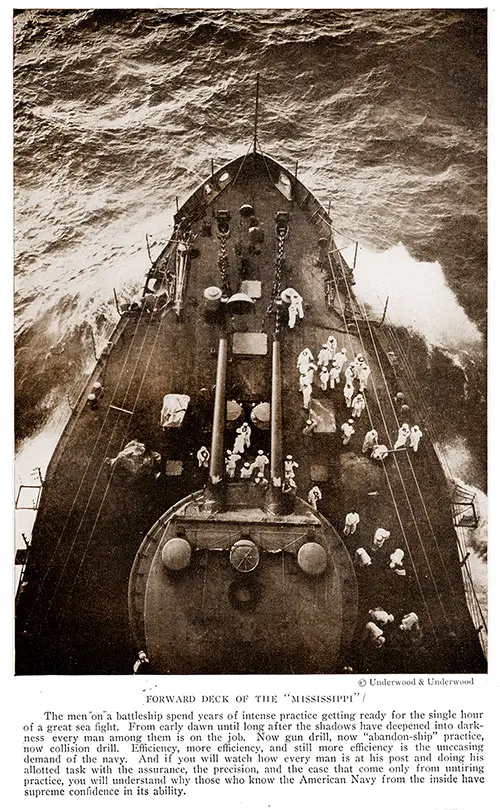
Forward Deck of the "Mississippi”. The Men on a Battleship Spend Years of Intense Practice Getting Ready for the Single Hour of a Great Sea Fight. From Early Dawn Until Long After the Shadows Have Deepened Into Darkness Every Man Among Them Is on the Job. Now Gun Drill, Now “Abandon-Ship” Practice, Now Collision Drill. Efficiency, More Efficiency, and Still More Efficiency Is the Unceasing Demand of the Navy. and if You Will Watch How Every Man Is at His Post and Doing His Allotted Task With the Assurance, the Precision, and the Ease That Come Only From Untiring- Practice, You Will Understand Why Those Who Know the American Navy From the Inside Have Supreme Confidence in Its Ability. Photograph © Underwood & Underwood. GGA Image ID # 184ea0419c
Address by Hon. Josephus Daniels, Secretary of the Navy, before the National Geographic Society, Washington, D. C., Friday, March 29, 1918.
In widespread acceptance, the navy is a fighting organization. Unless it is ready to fight and win victories, it fails its primary purpose.
Its chief aim and object is national defense. In a time of peace, it studies and learns, and in time of war, it practices the art of naval warfare.
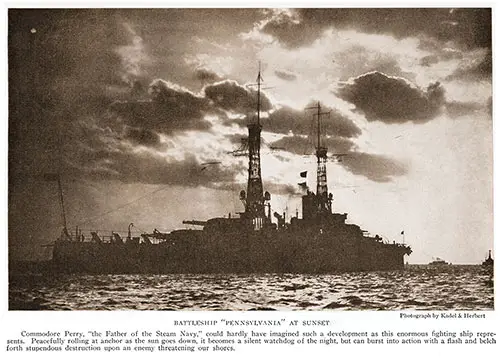
Battleship "Pennsylvania” at Sunset. Commodore Perry, “the Father of the Steam Navy,” Could Hardly Have Imagined Such a Development as This Enormous Fighting Ship Represents. Peacefully Rolling at Anchor as the Sun Goes Down, It Becomes a Silent Watchdog of the Night, but Can Burst Into Action With a Flash and Belch Forth Stupendous Destruction Upon an Enemy Threatening Our Shores. Photograph by Kadel & Herbert. GGA Image ID # 184ec51fb8
In the naval service, men are in training for a generation to fight, perhaps, for only a single day. But such a day! as when John Paul Jones said:
- “I have not yet begun to fight,” as he boarded the enemy ship and sailed away with his prize;
- or when Lawrence won immortal fame by his admonition to his associates, “Don’t give up the ship”;
- or when Perry, in his hour of triumph, sent the message, “We have met the enemy and they are ours”;
- or when Macdonough won the decisive victory on Lake Champlain;
- or when the Monitor and the Merrimac ushered in a revolution in naval construction and warfare as they clashed in mortal combat at Hampton Roads;
- or when Farragut steamed into Mobile Bay, heeding not the torpedoes;
- or when Dewey’s guns at Manila conquered Spanish sea power and Dewey’s diplomacy prevented German aggression;
- or when a few weeks ago the destroyer Fanning, assisted by the Nicholson, captured the whole crew and sank a German U-boat. Naval battles are always short, sharp, decisive.
It is because the tactics and the strategy call for quickness and the battle are won or lost in a few minutes that there are glamour and a fascination and glory in encounters at sea that appeal to the imagination more strongly than the more significant and more sanguinary conflicts on land.
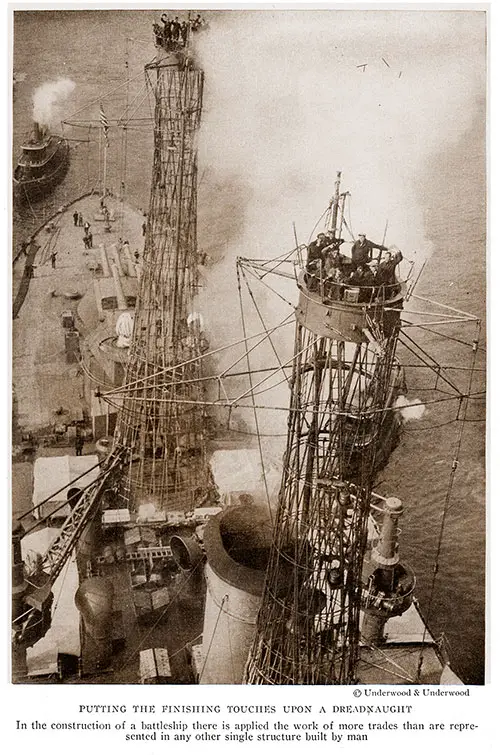
Putting the Finishing Touches Upon a Dreadnaught. in the Construction of a Battleship There Is Applied the Work of More Trades Than Are Represented in Any Other Single Structure Built by Man. Photograph © Underwood & Underwood. GGA Image ID # 1982429145
EVERY GENERATION HAS HAD ITS WAR
There has been, on an average, one war in every 29 years of our national life, and in most wars the naval engagements can be counted by minutes.
Men, therefore, spend most of their careers getting ready for the supreme moment. It may never come, but woe to that officer who lacks initiative and coolness and courage in the one moment when all he has learned and practiced is worthless unless he can summon it to his command upon the instant of decision!
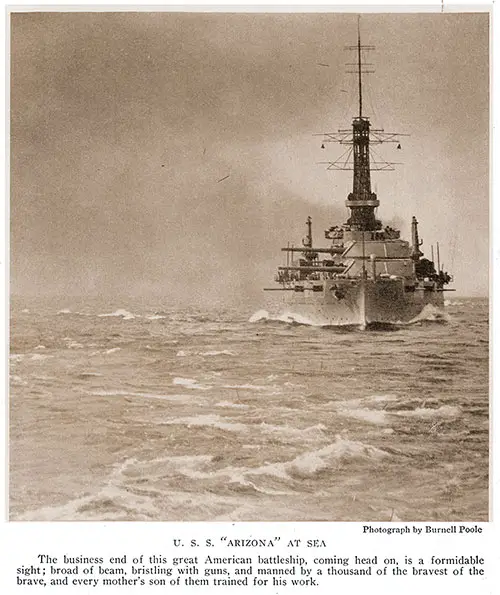
U. S. S. "Arizona" at Sea. the Business End of This Great American Battleship, Coming Head on, Is a Formidable Sight; Broad of Beam, Bristling With Guns, and Manned by a Thousand of the Bravest of the Brave, and Every Mother’s Son of Them Trained for His Work. Photograph by Burnell Poole. GGA Image ID # 184edffb24
Great generals have won renown who were masters of the defensive, and there are times when Fabian's methods on land spell victory. But at sea, the captain who depends upon defense is lost.
Offensive methods, daring attack, ability to maneuver to obtain the advantage, and shoot quickly and hit the enemy vessel—these are the essentials of high command afloat. They are only attained because the navy, in its shore establishments and afloat, is maintained and operated for the sole purpose of increasing the fighting efficiency of the fleet.
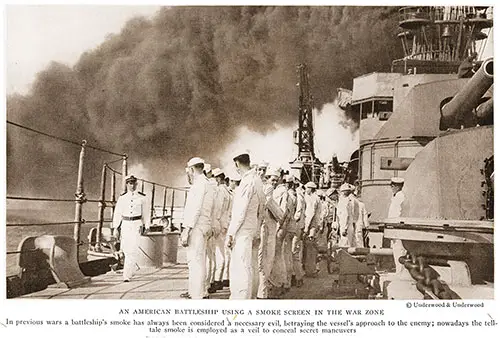
An American Battleship Using a Smoke Screen in the War Zone. In Previous Wars a Battleship’s Smoke Has Always Been Considered a Necessary Evil, Betraying the Vessel’s Approach to the Enemy; Nowadays the Tell-Tale Smoke Is Employed as a Veil to Conceal Secret Maneuvers. Photograph © Underwood & Underwood. GGA Image ID # 184f003e0a
In times such as these, we naturally think only of the fighting side of the navy. But just as we need, in the construction of a battleship, to apply the work of more trades than are used in any other single structure built by man, so the navy, in its organization, utilizes a vast number of the arts and sciences, and produces as by-products, so to speak, of its main work many results which are of general interest and application in the maritime, engineering, industrial, or purely scientific fields.
Thus, the navy maintains a large number of building and repair yards and a big gun factory that makes a majority of its guns.
In other words, the navy, as one of the largest employers of labor in the United States, has to deal not only with the problems incident to this but with problems of civil and mechanical engineering, such as must be handled in the industrial world.
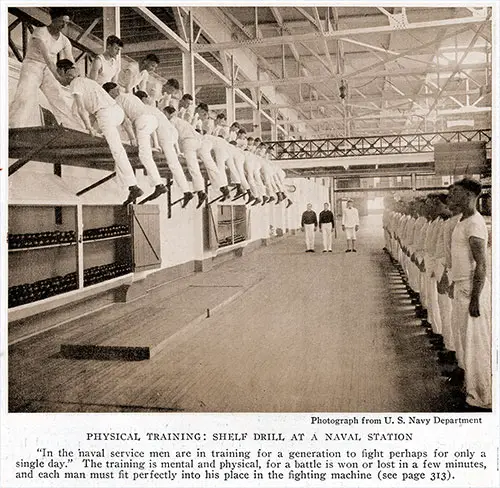
Physical Training: Shelf Drill at a Naval Station. “in the Naval Service Men Are in Training for a Generation to Fight Perhaps for Only a Single Day." the Training Is Mental and Physical, for a Battle Is Won or Lost in a Few Minutes, and Each Man Must Fit Perfectly Into His Place in the Lighting Machine. Photograph from US Navy Department. GGA Image ID # 184f00bfd7
The Navy Studies International Law
Even the Naval War College, founded primarily for the “study of problems of modern warfare in a manner at once scientific and practical,” is one of the few institutions of the United States where the science and problems of international law are carefully studied.
Officers of the navy are among our leading experts on international law, and, indeed, they need to be, for it falls to them more than to any other class in the country to apply the rules and principles of this science, which is somewhat neglected at present, when autocratic nations regard a solemn treaty as a mere scrap of paper.
Navigation—a special branch of astronomical science—is needed for every ship that crosses the ocean, merchant, and naval. For accurate navigation, there are required correct tables of the positions of the heavenly bodies at any time, instruments for observing the sun, moon, and stars, chronometers for determining correct time, and compasses for determining directions.
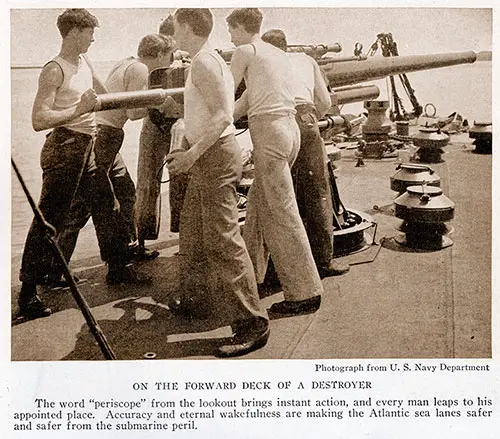
On the Forward Deck of a Destroyer. The Word “Periscope” From the Lookout Brings Instant Action, and Every Man Leaps to His Appointed Place. Accuracy and Eternal Wakefulness Are Making the Atlantic Sea Lanes Safer and Safer From the Submarine Peril. Photograph from US Navy Department. GGA Image ID # 184f162944
All work had to do with navigation is centered, for the navy, at the Naval Observatory in Washington, which compiles and publishes the Nautical Almanac, universally used; checks and corrects chronometers; studies compass problems and naval instruments generally. All of this work is freely given to the public and utilized by mariners generally.
The Hydrographic Office, another branch of the Navy Department, established more than fifty years ago by an act of Congress, has for its purpose, in the words of the act, “the improvement of the means for navigating safely the vessels of the navy and mercantile marine by providing . . . accurate and cheap nautical charts, sailing directions, navigators, and manuals of instruction . . for the benefit of navigators generally.”
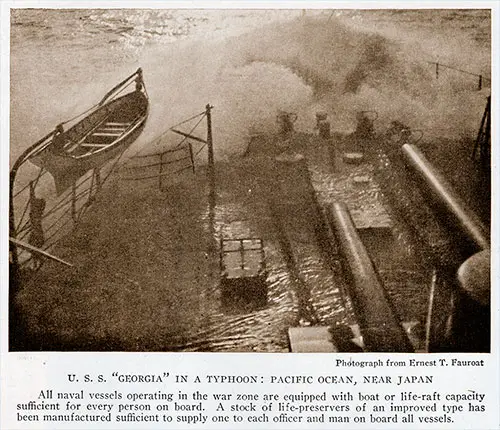
U. S. S. “Georgia” in a Typhoon : Pacific Ocean, Near Japan. All Naval Vessels Operating in the War Zone Are Equipped With Boat or Life-Raft Capacity Sufficient for Every Person on Board. a Stock of Life-Preservers of an Improved Type Has Been Manufactured Sufficient to Supply One to Each Officer and Man on Board All Vessels. Photograph from Ernest T. Fauroat. GGA Image ID # 184f3a642c
The Work of the Medical Corps
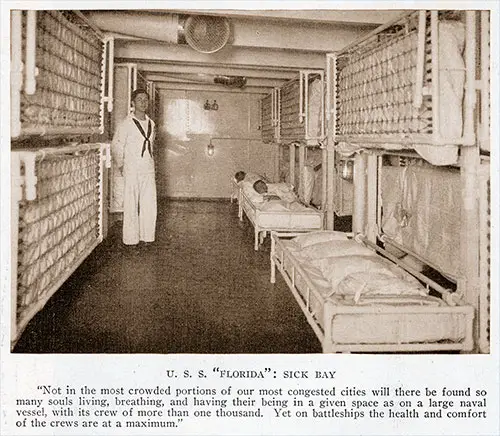
U. S. S. “Florida”: Sick Bay. “Not in the Most Crowded Portions of Our Most Congested Cities Will There Be Found So Many Souls Living, Breathing, and Having Their Being in a Given Space as on a Large Naval Vessel, With Its Crew of More Than One Thousand. Yet on Battleships the Health and Comfort of the Crews Are at a Maximum.” GGA Image ID # 184f8e341a
The principles of medical science apply to men in the navy and others, and the large and efficient Medical Corps of the navy has always contributed its share to the advancement of medical science generally.
In times of stress, such as these, when the Medical Corps is much more than doubled, it draws in medical men from civil life, with the result that in time of war, the relations between the naval doctor and the civilian doctor are even closer than in a time of peace. Many of the unique problems which the naval doctor has to deal with are found in civil life, and his knowledge and results are available for their solution.
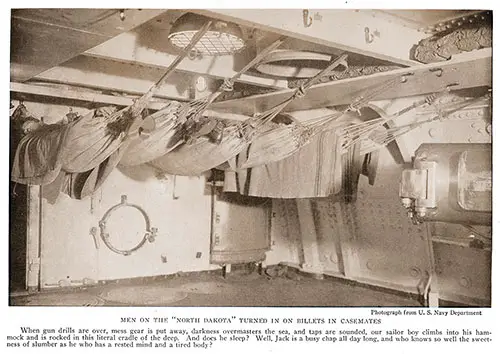
Men on the “North Dakota” Turned in on Bielets in Casemates. When Gun Drills Are. Over, Mess Gear Is Put Away, Darkness Overmasters the Sea, and Taps Are Sounded, Our Sailor Boy Climbs Into His Ham Mock and Is Rocked in This Literal Cradle of the Deep. and Does He Sleep? Well, Jack Is a Busy Chap All Day Long, and Who Knows So Well the Sweet Ness of Slumber as He Who Has a Rested Mind and a Tired Body? Photograph from U. S. Navy Department. GGA Image ID # 184fbb5212
For instance, not in the most crowded portions of our most congested cities will there be found so many souls living, breathing, and having their being in a given space as on a large naval vessel, with its crew of more than one thousand. Yet on battleships, the health and comfort of the crews are at a maximum.
In the mechanical field, as already indicated, the navy handles many problems whose solutions are of value in civil life. At the Experimental Model Basin, for instance, at the Washington Navy Yard, though devoted primarily to improving the shapes and lines of naval vessels, a large number of tests have been made for private shipbuilding companies, who have made free use of this plant in the preparation of designs for merchant vessels.
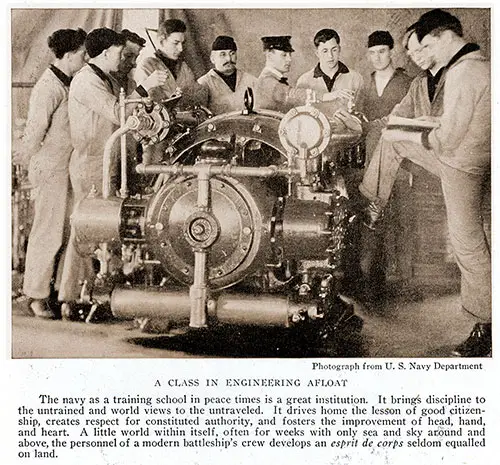
A Class in Engineering Afloat. The Navy as a Training School in Peace Times Is a Great Institution. It Brings Discipline to the Untrained and World Views to the Untraveled. It Drives Home the Lesson of Good Citizenship, Creates Respect for Constituted Authority, and Fosters the Improvement of Head, Hand, and Heart. a Little World Within Itself, Often for Weeks With Only Sea and Sky Around and Above, the Personnel of a Modern Battleship’s Crew Develops an Esprit de Corps Seldom Equaled on Land. Photograph from US Navy Department. GGA Image ID # 184fecbfb7
There is a Navy Experiment Station at Annapolis, with a mechanical and engineering laboratory. Before the war began, Congress authorized a large research laboratory that would generally give much information on engineering subjects, though primarily for navy use.
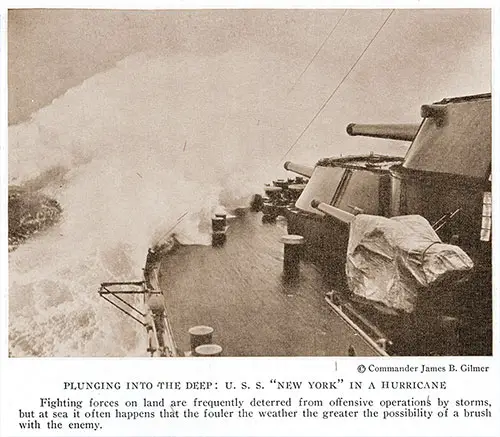
Plunging Into the Deep: U. S. S. “New York” in a Hurricane. Fighting Forces on Land Are Frequently Deterred From Offensive Operation^ by Storms, but at Sea It Often Happens That the Fouler the Weather the Greater the Possibility of a Brush With the Enemy. Photograph © Commander James B. Gilmer. GGA Image ID # 1850a77e1f
By-Products of Naval Activities
As this partial summary indicates, the navy as a by-product, so to speak, of its regular work makes progress in the arts and sciences which is of use (and made use of) in civil life.
Moreover, there has been a constant outflow of officers from the navy who engage in civilian pursuits in many cases with outstanding success in ordinary times. For example, a considerable proportion of this country's shipbuilding industry is now under the direction of former officers of the navy.
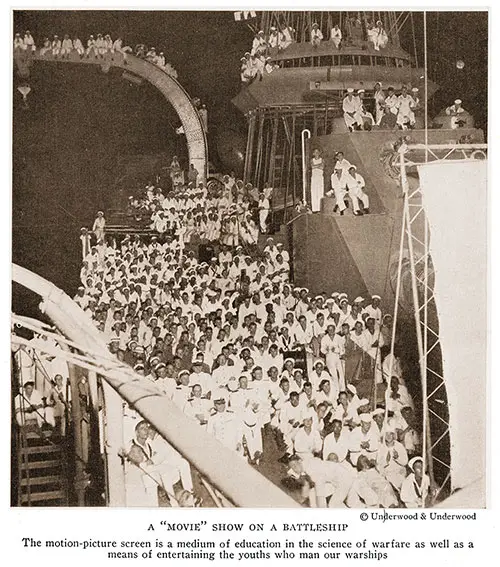
A “Movie” Show on a Battleship. The Motion-Picture Screen Is a Medium of Education in the Science of Warfare as Well as a Means of Entertaining the Youths Who Man Our Warships. Photograph © Underwood & Underwood. GGA Image ID # 1850da516f
There is, however, another side to this. The navy has always prided itself upon the fact that it made free use of the civil developments of the arts and sciences that are of value for its purposes. Something over two years ago, the Department undertook to systematize and further develop this principle by organizing the Naval Consulting Board to recognize the fundamental importance of scientific work and scientific specialists to the navy organization as a whole.
The Board is now made up of the most eminent scientists and inventors of this country, with Mr. Edison as its chairman and two representatives of eleven leading American technical societies. These societies all chose men distinguished in their respective professions. The result that the Board as a whole is composed of men of great individual prestige, and in this war, has devoted itself to the study of naval problems.
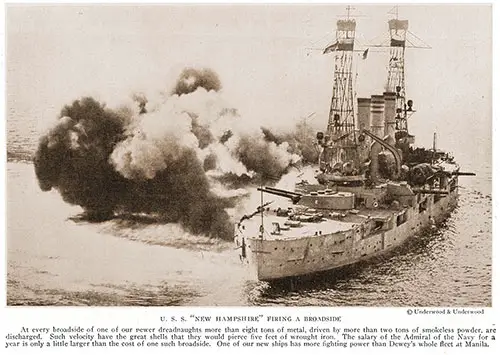
U. S. S. "New Hampshire" Firing a Broadside. At Every Broadside of One of Our Newer Dreadnaughts More Than Eight Tons of Metal, Driven by More Than Two Tons of Smokeless Powder, Are Discharged. Such Velocity Have the Great Shells That They Would Pierce Five Feet of Wrought Iron. the Salary of the Admiral of the Navy for a Year Is Only a Little Larger Than the Cost of One Such Broadside. One of Our New Ships Has More Fighting Power Than Dewey’s Whole Fleet at Manila. Photograph © Underwood & Underwood. GGA Image ID # 18512a5770
When the Navy Speaks for Itself
As the embodiment of power, the navy as a fighting agency, as the protector of the country from aggression, is today the pride and reliance of America. But that navy can speak for itself, is speaking for itself through its more than 350,000 men and more than 1,000 ships now in active service, and will talk about greater emphasis when the hour comes for which all other hours have been but preparation.
Never did a nation have more right to be proud of its navy than America has now, and never were fighting ships operated by men of such skill and courage as our fleet is today. Let us send to them across the ocean, in their vigils and perils, a message of cheer, a message of confidence, and pride.
Once in 29 years, the navy is called upon to fight. If in all the 26 years of peace, for war usually lasts three years, its officers and men concerned themselves only with getting and keeping ready, the feeling of safety such a navy affords would be worth all that it costs.
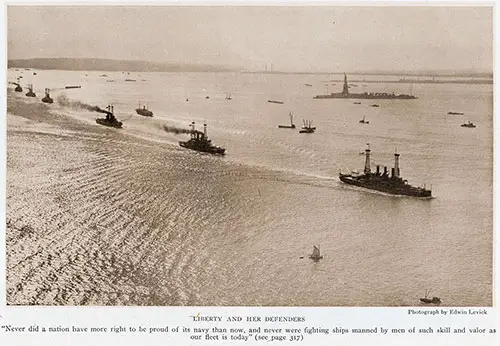
Liberty and Her Defenders. ‘‘Never Did a Nation Have More Right to Be Proud of Its Navy Than Now, and Never Were Fighting Ships Manned by Men of Such Skill and Valor as Our Fleet Is Today." Photograph by Edwin Levick. GGA Image ID # 1851462b71
Today we have all come to agree with Gouverneur Morris, who, when referring to the navy and the expense, therefore, said in the Senate:
“When we have 20 ships of the line at sea we shall be respected by all Europe. The expense compared with the benefit is moderate— nay, trifling. Whatever sums are necessary to secure national independence must be paid. If we will not pay to be defended we must pay for being conquered.”
Those words never sounded so true as today. They have in them the ring of prophecy and warning.
In the intervals between wars, the navy has not found its only occupation in practice and drill and maneuvers, in simulated warfare, making ready against the day when it would be helpless unless it is always prepared.
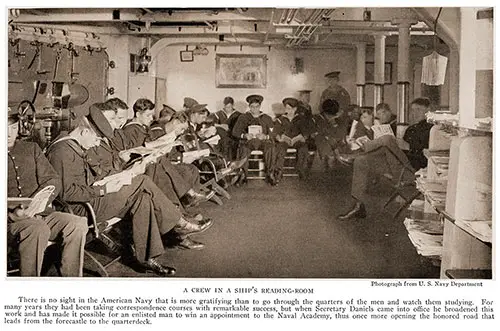
A Crew in a Ship's Reading-Room. I Here Is No Sight in the American Navy That Is More Gratifying Than to Go Through the Quarters of the Men and Watch Them Studying. for Many Years They Had. Been Taking Correspondence Courses With Remarkable Success, but When Secretary Daniels Came Into Office He Broadened This Work and Has Made It Possible for an Enlisted Man to Win an Appointment to the Naval Academy, Thus Once More Opening the Honored Road That Leads From the Forecastle to the Quarterdeck. Photograph from U. S. Navy Department. GGA Image ID # 18515a3c08
The Navy as an Institution in Peace Times
In many ways, it has demonstrated its necessity as a peace institution, and in its contribution to the spread of knowledge, to the extension of commerce by opening new doors to hitherto unknown peoples, to the discovery of new worlds, to the charting of the seas, to pioneer work in securing victories through diplomacy, to the study of the stars, to decreasing the time of ocean voyages and cheapening traffic by the sea—in these and other ways the American Navy has been a leader, and all the world is a debtor to it, because, aside from its place as a fighting machine, it has been a pathfinder in days of peace.
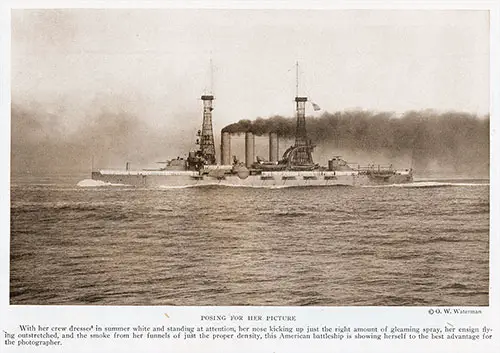
Posing for Her Picture. With Her Crew Dressed in Summer White and Standing at Attention, Her Nose Kicking up Just the Right Amount of Gleaming Spray, Her Ensign Flying Outstretched, and the Smoke From Her Funnels of Just the Proper Density, This American Battleship Is Showing Herself to the Best Advantage for the Photographer. Photograph © O. W. Waterman. GGA Image ID # 18515bdaea
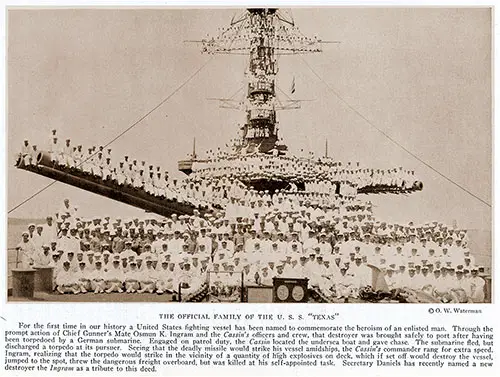
The Official Family of the U. S. S. Texas. For the First Time in Our History a United States Fighting Vessel Has Been Named to Commemorate the Heroism of an Enlisted Man. Through the Prompt Action of Chief Gunner’s Mate Osmun K. Ingram and the Cassin’s Officers and Crew, That Destroyer Was Brought Safely to Port After Having Been Torpedoed by a German Submarine. Engaged on Patrol Duty, the Cassin Located the Undersea Boat and Gave Chase. the Submarine Fled, but Discharged a Torpedo at Its Pursuer. Seeing That the Deadly Missile Would Strike His Vessel Amidships, the Cassin’s Commander Rang for Extra Speed. Ingram, Realizing That the Torpedo Would Strike in the Vicinity of a Quantity of High Explosives on Deck, Which if Set off Would Destroy the Vessel, Jumped to the Spot, Threw the Dangerous Freight Overboard, but Was Killed at His Self-Appointed Task. Secretary Daniels Has Recently Named a New Destroyer the Ingram as a Tribute to This Deed. Photograph © O. W. Waterman. GGA Image ID # 185163c2a6
Hon. Josephus Daniels, "The Gem of the Ocean - Our American Navy," in The National Geographic Magazine, Washington, DC: The National Geographic Society, Vol. XXXIII, No. 4, April 1918, pp. 315-
